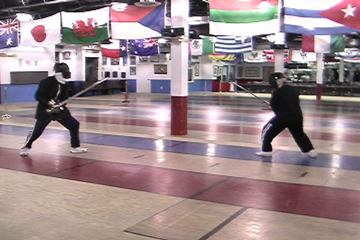About
Historical Background
Longsword Combat
The Rise of the Rapier
Misconceptions
Reconstruction
WMA Practice
What HES Is Not
Bouts
Home
|
Since it required two
hands to use effectively, the longsword was not used in conjunction with any
kind of shield or buckler, as earlier swords had been. Instead, the sword
itself had to take on the defensive role of shield, and this simultaneously
defensive and offensive use of a single blade came to characterize European swordsmanship ever since. Even after the longsword
gave way to later types of single-handed sword, such as the rapier (the long
civilian dueling weapon of the 17th century) and its descendants the smallsword and epee, the basic
principle that the swordsman relies on the sword for defense as well as attack
has remained operative. There are, however,
different ways – and different philosophies – of how to attack and
defend.
Historically, European martial arts
were no more uniform than those of Asia. The Alps were a major cultural
dividing line across Europe during the heyday of the longsword. Just as the
paintings of the 15th-century Italian masters Botticelli or Fra Angelico look very different
from their northern contemporaries such as Durer or van Eyck, different regional sword arts of the 15th century also look very different.
The Italian
masters of the period, Fiore de Liberi and Filippo Vadi, taught a style of longsword that had a
distinctive Latin elegance and flair; as the modern longsword teacher and
writer Guy Windsor puts it: "Though Italy as a unified political entity was
four hundred years in the future, the Italian style, which would culminate in
Ferrari and Armani, breathes life into the pages of [their] long-forgotten
treatises." Several modern schools teach the Italian style, including, in the
U.S., Schola St. George and the Chicago Swordplay Guild; and in Europe, Schola
Gladiatoria (London) and Windsor's School of European Swordsmanship, Helsinki.
The northern school was
quite different. If Fiore's proud and elegant style of swordfighting breathes
the same spirit as Armani or Ferrari (i.e., glorifying the human
body, in keeping with humanistic principles that were central to the Italian
Renaissance), the efficient German style reflects the cultural spirit of
Bauhaus or BMW. Most authors of
German fighting manuals – or fechtbucher – acknowledge the founder of their art to
be the 14th-century German fencing master Johannes Liechtenauer.
Little is known about
Liechtenauer. He was probably a traveling fencing teacher, who may or may not
have actually invented the method that is associated with his name; it is
possible he simply codified and recorded a system that was already in wide use.
Either way, he earned his place in history by setting down his teachings in a
cryptic poem – a typical pedagogical device of the time – which
promoted both retention of material by his students (it was a mnemonic poem) as
well as secrecy from the uninitiated: You couldn't understand it unless you had
already been taught the fighting system by somebody. Fortunately, several heirs
to the Liechtenauer tradition (who may or may not have been his actual
students) not only recorded this poem but also wrote their own commentaries on
it. The mid-15th-century fechtbuch of Sigmund Ringeck, for example, explained in detail what each line of Liechtenauer's poem meant.
Ringeck's work, as well as books by Hans Talhoffer, Hanko Dobringer and several
others (all paying homage to Liechtenauer), have been the basis for the modern
reconstruction of the "Liechtenauer" fighting method.
The German efficiency of
swordplay engineering can be seen in the overriding preference for single-time
as opposed to double-time attack and defense. Single-time means attacking with
the same motion with which you defend yourself; double-time means using
separate motions for each purpose. Modern foil or saber fencing, for example,
utilizes double-time attack and defense, and thus you may see sport fencers fight
in a rapid alternating rhythm: attack-parry-attack. In the German longsword
system, there is ideally no attack that does not simultaneously close off a
line of attack from your opponent, and there is no defense – no parry
– that does not at the same time threaten (ideally, hit) your opponent.
This produces a very distinctive-looking sort of fight, with a distinctive
temporal flavor and rhythm. As a result of the preference for efficient
single-time motions, the German system is built around five meisterhau or "master-strikes" – moves that fulfill a
simultaneous offensive and defensive function. (There is nothing similar to the
master strikes in the Italian system, although the Italian masters also laud
single-time, or mezzo-tempo,
actions.)
Schools that teach the
German method include, in the U.S., the Virginia Academy of Fencing and MASHS
(both in the Washington, DC – Baltimore area), the Selohaar Fechtschule
(CT), and the Rocky Mountain Historical Combat Guild (CO), as well as Ochs Historische
Kampfkunste in Germany, and Stoccata School of Defence in Australia.
Next
page: The Rise of the Rapier | |

